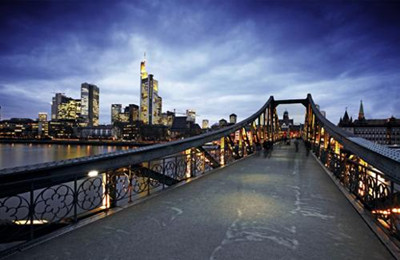在圣保羅騎行
Tropic of Copenhagen
熱帶的哥本哈根
A city fights its car addiction
城市戒車癮
SaO PAULO'S obsession with the automobile is well documented. It first hosted a Formula 1 Grand Prix in 1973; a motorway is named after Ayrton Senna, a local son and three-time world champion killed in a crash 20 years ago. The city has 5.6m cars, nearly one for every two people. The result is congestion. Taken together, afternoon jams often exceed 100km (62 miles). One recent study found that the average paulistano spends nearly three hours in daily commutes.
The city's mayor, Fernando Haddad, says this cannot go on. Since taking office in 2013 he has tried to cajole paulistanos out of cars and onto bicycles. On November 18th a 700-metre stretch of cycle lanes was completed, bringing the total to 179km. Fully 117km have been laid since June, more than in the previous 33 years, when city hall first mulled them. Mr Haddad has promised 400km by the end of 2015, which would put the city on a par with cycle-centric Copenhagen.
He faces an uphill climb worthy of the Tour de France. Sao Paulo is not naturally bike-friendly. Multi-lane arteries and ring roads link the periphery, where most people live, to the centre where the jobs are. This creates sprawl.
巴西圣保羅州對汽車的癡迷從檔案就可見一斑。早在1973年,該州就舉辦過F1一級方程式錦標賽;有一個賽車道就是以埃爾頓·塞納命名的,他是當?shù)厝耍@得三次世界冠軍,但是在20年前的一次事故中這顆巨星不幸隕落。這座城市的汽車保有量達到560萬,幾乎每兩個人就擁有一部汽車。其后果就是交通堵塞。堵塞路段加起來,下午的堵塞經(jīng)常超過100千米(約合62英里)。近期的一項調(diào)查發(fā)現(xiàn),圣保羅人每天花在路上的時間平均下來將近3小時。圣保羅市長費爾南多·哈達德稱這一現(xiàn)象將會終止。自2013年上任以來,他努力勸導圣保羅人放棄開汽車改騎自行車。11月18日,一條寬700米的自行車道竣工,全場179千米。自六月以來,117千米的自行車道就已竣工,這比33年以前的總和還多,那時市政廳就對此作仔細考慮。哈達德承諾到2015年自行車道里程將達到400千米,而這,將會使圣保羅市與自行車驅(qū)動的哥本哈根一樣。他所面臨的上坡路其意義堪比環(huán)法自行車賽。圣保羅并不是一開始就十一自行車出行。多車道要道和環(huán)城路連接了城郊,這些城郊容納了該市主要人口,讓他們能夠到市中心工作。于是導致了圣保羅市的無計劃擴張。

Unlike Buenos Aires, which has taken to two wheels with gusto, Sao Paulo is also muscle-strainingly hilly. It is unsafe, too. In London, with more bicycle trips, 14 cyclists perished in traffic last year; in Sao Paulo 37 did. Many drivers have little patience for non-motorised road users.
與首都布宜諾斯艾利斯適宜兩輪自行車不同的是,圣保羅多山,騎行非常累,而且不安全。在倫敦,由于人們騎自行車遠足,去年14個自行車手死于交通事故,而圣保羅的數(shù)據(jù)是37人。許多駕駛員對非機動車道路上的騎行者沒有一點耐心。
Nine in ten paulistanos say they want the cycle network extended. In practice, some are less keen. In the short run congestion may worsen as bike lanes impinge on precious road space. Vicente Safon, who runs a bakery in Higienópolis, a leafy district, came to work recently to find one being traced on his doorstep. Deliveries of flour in 50kg (110lb) sacks had to be lugged from a distant side street. Mr Safon complained; a 50-metre stretch was painted over in asphalt grey—to the relief of the baker, if not the bikers, who now find themselves in a car lane with no warning.Such kerfuffles are inevitable, says Leonardo Barchini, a city-hall spokesman. He hopes the kinks can be ironed out, for instance by allowing delivery vehicles to stop on bike lanes at certain times.
圣保羅人里十個有九個稱他們希望拓展他們城市的自行車道網(wǎng)絡(luò)。實際上,有些人的意愿并不是那么熱切。短期來看,由于自行車道對之前的公路系統(tǒng)有影響,交通擁堵的狀況可能會加劇。文森特·賽風在Higienópolis經(jīng)營一家面包店,該地區(qū)樹木眾多。近期來工作的他發(fā)現(xiàn)自行車道都修到他的門口。運送50千克一麻袋的面粉不得不從很遠的街道另一邊拖過來。賽風抱怨道,50米寬的車道被涂上瀝青灰,以讓面包師安心。倘若不是那些騎行者,誰會在沒有警告的機動車道危險穿行。市政廳的發(fā)言人Leonardo Barchini聲稱這樣的混亂是不可避免的。他希望這讓人著惱的事能盡快得到解決,比如在特定的時間段允許貨運車暫時停靠在自行車道。
Changing Sao Paulo's car culture will be hard, admits Nabil Bonduki, a city-council man leading the pro-cycling peloton. But he takes heart from Copenhagen. When the Danish capital first mooted bike lanes 30 years ago many residents were dead-set against them. Now 36% of commuter trips are by cycle.
納比爾,圣保羅市委員會倡導自行車化集團的首領(lǐng)承認改變圣保羅市的汽車文化任重道遠。但是他從哥本哈根獲得勇氣和啟迪。30年前,丹麥首都哥本哈根開始商討修建自行車道時,許多居民都堅決反對。然而現(xiàn)在36%的遠足都是騎行發(fā)生的。譯者:占文英












